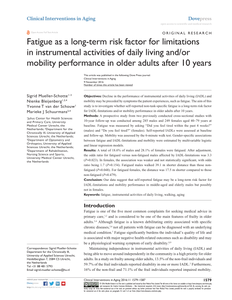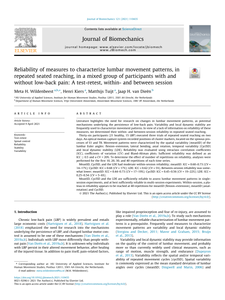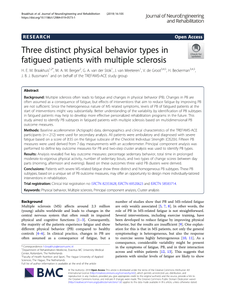This paper outlines an investigation into the updating of fatigue reliability through inspection data by means of structural correlation. The proposed methodology is based on the random nature of fatigue fracture growth and the probability of damage detection and introduces a direct link between predicted crack size and inspection results. A distinct focus is applied on opportunities for utilizing inspection information for the updating of both inspected and uninspected (or uninspectable) locations.
DOCUMENT

Objectives: Decline in the performance of instrumental activities of daily living (IADL) and mobility may be preceded by symptoms the patient experiences, such as fatigue. The aim of this study is to investigate whether self-reported non-task-specific fatigue is a long-term risk factor for IADL-limitations and/or mobility performance in older adults after 10 years. Methods: A prospective study from two previously conducted cross-sectional studies with 10-year follow-up was conducted among 285 males and 249 females aged 40–79 years at baseline. Fatigue was measured by asking “Did you feel tired within the past 4 weeks?” (males) and “Do you feel tired?” (females). Self-reported IADLs were assessed at baseline and follow-up. Mobility was assessed by the 6-minute walk test. Gender-specific associations between fatigue and IADL-limitations and mobility were estimated by multivariable logistic and linear regression models. Results: A total of 18.6% of males and 28.1% of females were fatigued. After adjustment, the odds ratio for fatigued versus non-fatigued males affected by IADL-limitations was 3.3 (P=0.023). In females, the association was weaker and not statistically significant, with odds ratio being 1.7 (P=0.154). Fatigued males walked 39.1 m shorter distance than those non-fatigued (P=0.048). For fatigued females, the distance was 17.5 m shorter compared to those non-fatigued (P=0.479). Conclusion: Our data suggest that self-reported fatigue may be a long-term risk factor for IADL-limitations and mobility performance in middle-aged and elderly males but possibly not in females.
DOCUMENT

Purpose: To study the association between fatigue and participation and QoL after acquired brain injury (ABI) in adolescents and young adults (AYAs). Materials & Methods: Cross-sectional study with AYAs aged 14–25 years, diagnosed with ABI. The PedsQL™ Multidimensional Fatigue Scale, Child & Adolescent Scale of Participation, and PedsQL™4.0 Generic Core Scales were administered. Results: Sixty-four AYAs participated in the study, 47 with traumatic brain injury (TBI). Median age at admission was 17.6 yrs, 0.8 yrs since injury. High levels of fatigue (median 44.4 (IQR 34.7, 59.7)), limited participation (median 82.5 (IQR 68.8, 92.3)), and diminished QoL (median 63.0 (IQR 47.8, 78.3)) were reported. More fatigue was significantly associated with more participation restrictions (β 0.64, 95%CI 0.44, 0.85) and diminished QoL (β 0.87, 95%CI 0.72, 1.02). Conclusions: AYAs with ABI reported high levels of fatigue, limited participation and diminished quality of life with a significant association between fatigue and both participation and QoL. Targeting fatigue in rehabilitation treatment could potentially improve participation and QoL.
MULTIFILE

Literature highlights the need for research on changes in lumbar movement patterns, as potential mechanisms underlying the persistence of low-back pain. Variability and local dynamic stability are frequently used to characterize movement patterns. In view of a lack of information on reliability of these measures, we determined their within- and between-session reliability in repeated seated reaching. Thirty-six participants (21 healthy, 15 LBP) executed three trials of repeated seated reaching on two days. An optical motion capture system recorded positions of cluster markers, located on the spinous processes of S1 and T8. Movement patterns were characterized by the spatial variability (meanSD) of the lumbar Euler angles: flexion–extension, lateral bending, axial rotation, temporal variability (CyclSD) and local dynamic stability (LDE). Reliability was evaluated using intraclass correlation coefficients (ICC), coefficients of variation (CV) and Bland-Altman plots. Sufficient reliability was defined as an ICC ≥ 0.5 and a CV < 20%. To determine the effect of number of repetitions on reliability, analyses were performed for the first 10, 20, 30, and 40 repetitions of each time series. MeanSD, CyclSD, and the LDE had moderate within-session reliability; meanSD: ICC = 0.60–0.73 (CV = 14–17%); CyclSD: ICC = 0.68 (CV = 17%); LDE: ICC = 0.62 (CV = 5%). Between-session reliability was somewhat lower; meanSD: ICC = 0.44–0.73 (CV = 17–19%); CyclSD: ICC = 0.45–0.56 (CV = 19–22%); LDE: ICC = 0.25–0.54 (CV = 5–6%). MeanSD, CyclSD and the LDE are sufficiently reliable to assess lumbar movement patterns in single-session experiments, and at best sufficiently reliable in multi-session experiments. Within-session, a plateau in reliability appears to be reached at 40 repetitions for meanSD (flexion–extension), meanSD (axial-rotation) and CyclSD.
MULTIFILE

In order to guarantee structural integrity of marine structures in an effective way, operators of these structures seek an affordable, simple and robust system for monitoring detected cracks. Such systems are not yet available and the authors took a challenge to research a possibility of developing such a system. The paper describes the initial research steps made. In the first place, this includes reviewing conventional and recent methods for sensing and monitoring fatigue cracks and discussing their applicability for marine structures. A special attention is given to the promising but still developing new sensing techniques. In the second place, wireless network systems are reviewed because they form an attractive component of the desired system. The authors conclude that it is feasible to develop the monitoring system for detected cracks in marine structures and elaborate on implications of availability of such a system on risk based inspections and structural health monitoring systems
DOCUMENT

Background To gain insight into the role of plantar intrinsic foot muscles in fall-related gait parameters in older adults, it is fundamental to assess foot muscles separately. Ultrasonography is considered a promising instrument to quantify the strength capacity of individual muscles by assessing their morphology. The main goal of this study was to investigate the intra-assessor reliability and measurement error for ultrasound measures for the morphology of selected foot muscles and the plantar fascia in older adults using a tablet-based device. The secondary aim was to compare the measurement error between older and younger adults and between two different ultrasound machines. Methods Ultrasound images of selected foot muscles and the plantar fascia were collected in younger and older adults by a single operator, intensively trained in scanning the foot muscles, on two occasions, 1–8 days apart, using a tablet-based and a mainframe system. The intra-assessor reliability and standard error of measurement for the cross-sectional area and/or thickness were assessed by analysis of variance. The error variance was statistically compared across age groups and machines. Results Eighteen physically active older adults (mean age 73.8 (SD: 4.9) years) and ten younger adults (mean age 21.9 (SD: 1.8) years) participated in the study. In older adults, the standard error of measurement ranged from 2.8 to 11.9%. The ICC ranged from 0.57 to 0.97, but was excellent in most cases. The error variance for six morphology measures was statistically smaller in younger adults, but was small in older adults as well. When different error variances were observed across machines, overall, the tablet-based device showed superior repeatability. Conclusions This intra-assessor reliability study showed that a tablet-based ultrasound machine can be reliably used to assess the morphology of selected foot muscles in older adults, with the exception of plantar fascia thickness. Although the measurement errors were sometimes smaller in younger adults, they seem adequate in older adults to detect group mean hypertrophy as a response to training. A tablet-based ultrasound device seems to be a reliable alternative to a mainframe system. This advocates its use when foot muscle morphology in older adults is of interest.
MULTIFILE

The aim of this paper is to show the benefits of enhancing classic Risk Based Inspection (without fatigue monitoring data) with an Advisory Hull Monitoring System (AHMS) to monitor and justify lifetime consumption to provide more thorough grounds for operational, inspection, repair and maintenance decisions whilst demonstrating regulatory compliance.
DOCUMENT

Abstract: The key challenge of managing Floating Production Storage and Offloading assets (FPSOs) for offshore hydrocarbon production lies in maximizing the economic value and productivity, while minimizing the Total Cost of Ownership and operational risk. This is a comprehensive task, considering the increasing demands of performance contracting, (down)time reduction, safety and sustainability while coping with high levels of phenomenological complexity and relatively low product maturity due to the limited amount of units deployed in varying operating conditions. Presently, design, construction and operational practices are largely influenced by high-cycle fatigue as a primary degradation parameter. Empirical (inspection) practices are deployed as the key instrument to identify and mitigate system anomalies and unanticipated defects, inherently a reactive measure. This paper describes a paradigm-shift from predominant singular methods into a more holistic and pro-active system approach to safeguard structural longevity. This is done through a short review of several synergetic Joint Industry Projects (JIP’s) from different angles of incidence on enhanced design and operations through coherent a-priori fatigue prediction and posteriori anomaly detection and -monitoring.
DOCUMENT

Background: Multiple sclerosis often leads to fatigue and changes in physical behavior (PB). Changes in PB are often assumed as a consequence of fatigue, but effects of interventions that aim to reduce fatigue by improving PB are not sufficient. Since the heterogeneous nature of MS related symptoms, levels of PB of fatigued patients at the start of interventions might vary substantially. Better understanding of the variability by identification of PB subtypes in fatigued patients may help to develop more effective personalized rehabilitation programs in the future. This study aimed to identify PB subtypes in fatigued patients with multiple sclerosis based on multidimensional PB outcome measures. Methods: Baseline accelerometer (Actigraph) data, demographics and clinical characteristics of the TREFAMS-ACE participants (n = 212) were used for secondary analysis. All patients were ambulatory and diagnosed with severe fatigue based on a score of ≥35 on the fatigue subscale of the Checklist Individual Strength (CIS20r). Fifteen PB measures were used derived from 7 day measurements with an accelerometer. Principal component analysis was performed to define key outcome measures for PB and two-step cluster analysis was used to identify PB types. Results: Analysis revealed five key outcome measures: percentage sedentary behavior, total time in prolonged moderate-to-vigorous physical activity, number of sedentary bouts, and two types of change scores between day parts (morning, afternoon and evening). Based on these outcomes three valid PB clusters were derived. Conclusions: Patients with severe MS-related fatigue show three distinct and homogeneous PB subtypes. These PB subtypes, based on a unique set of PB outcome measures, may offer an opportunity to design more individually-tailored interventions in rehabilitation.
MULTIFILE

Background: Pain assessment is a necessary step in pain management in older people in palliative care. In older people, pain assessment can be challenging due to underreporting and atypical pain manifestations by other distressing symptoms. Anxiety, fatigue, loss of appetite, nausea, insomnia, dyspnoea, and bowel problems correlate with pain in palliative care patients. Insight into these symptoms as predictors may help to identify the underlying presence of pain. This study aimed to develop and test a prediction model for pain in community-dwelling frail older people in palliative care. Methods: In this cross-sectional observational study, community-care nurses from multiple organizations across the Netherlands included eligible patients (life expectancy < 1 year, aged 65+, community-dwelling and frail). The outcome pain and symptoms were assessed by means of the Utrecht Symptom Diary. Also, demographic and illness information, including relevant covariates age, sex and living situation, was collected. Multivariable logistic regression and minimum Akaike Information Criterion(AIC) were used for model development and Receiver Operating Characteristics(ROC)-analysis for model performance. Additionally, predicted probability of pain are given for groups differing in age and sex. Results: A total of 157 patients were included. The final model consisted of insomnia(Odds Ratio[OR] = 2.13, 95% Confidence Interval[CI] = 1.01–1.30), fatigue(OR = 3.47, 95% CI = 1.11–1.43), sex(female)(OR = 3.83, 95% CI = 2.11–9.81) and age(OR=-1.59, 95% CI = 0.92–1.01) as predicting variables. There is an overall decreasing trend for age, older persons suffer less from pain and females have a higher probability of experiencing pain. Model performance was indicated as fair with a sensitivity of 0.74(95% CI = 0.64–0.83) and a positive predictive value of 0.80(95% CI = 0.70–0.88). Conclusions: Insomnia and fatigue are predicting symptoms for pain, especially in women and younger patients. Further testing of the model in external cohorts is needed before clinical adoption.
LINK